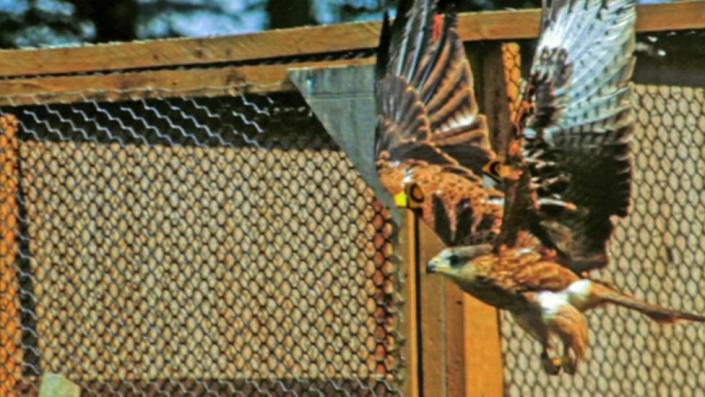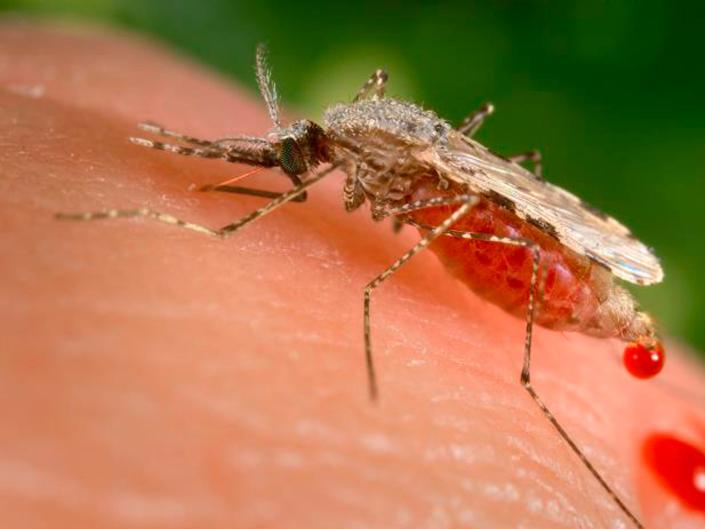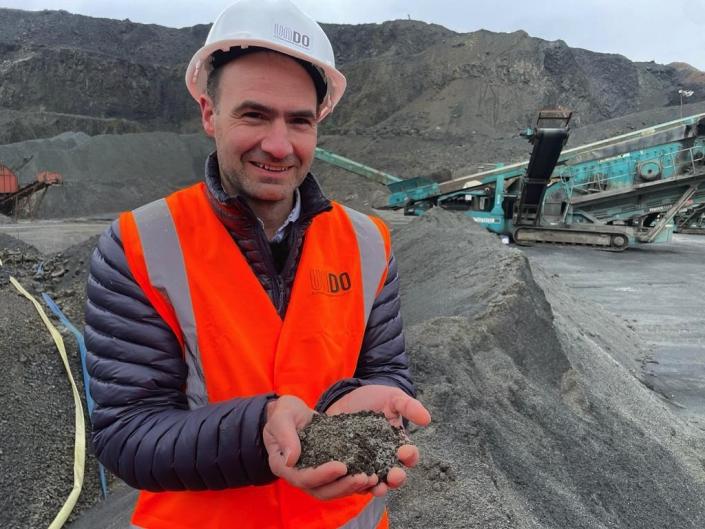Science Daily News | 21 May 2023

Views (193)

One of the first red kites released into Thames Valley dies
The bird, called Aragon, was among the first chicks brought over from Spain in 1994.

One of the first red kites brought to the UK as part of a successful reintroduction programme in the early 1990s has died.
The bird, called Aragon, was found injured outside a school in Carterton, Oxfordshire, and rescued by bird sanctuary owner Chrissie Gaines.
After he died of his injuries she found he was from the second batch of chicks brought over from Spain in 1994.
Aragon, aged 29, is believed to have been one of the UK's oldest red kites.
Aragon was originally released on the Wormsley Estate in Buckinghamshire and has stayed in the Thames Valley area near the Chilterns.
Ms Gaines, who runs Chrissie's Owls and a sanctuary for rescued birds of prey, received a phone call from staff at Gateway Primary School in Carterton after he was discovered on a path.
She said: "We think he'd been attacked by other birds, he was very badly injured and in a mess when I took him to the vets, they gave him antibiotics and I took him home.
"I had a couple of sleepless nights with him and he seemed to be picking up, but then things changed sadly.
"I realised he had a ring on him and contacted a friend with the number to find out more."
That's when Ms Gaines discovered the bird's history, and that the ring was fitted by Dr Mike Pienowski, who was part of the original team who reintroduced the red kites in the 1990s.
She said: "I couldn't believe it, we know the conservation project to release the kites has been a success, but had Aragon not been found we wouldn't know how old the original group had lived to - we think he's now the oldest red kite in the UK as the last one recorded was 25.
"In all my years working with birds I've never heard anything like it, usually birds don't live very long when they're released back into the wild.
"So he mustn't be forgotten, bless him, he's part of history."
Hemsby erosion: 'I knew it would happen but not this quickly'
Once a village whose beach attracted thousands, Hemsby is now the the face of an eroding coast.

There's not much retired fisherman Kenny Chaney doesn't know about the Norfolk village of Hemsby. Despite working from Hemsby's beach for 52 years, the rate of coastal erosion has surprised even him.
An avid photographer and collector of postcards, Mr Chaney has built up a personal pictorial archive of Hemsby.
His collection charts not just his own life in the village, currently home to about 3,200 people, but also its gradual swallowing up by the sea.
He holds one photograph showing a vast, golden beach with thousands of holidaymakers enjoying a sunny day there.
"When I started fishing back in 1957, it was a really bustling holiday place - you couldn't move down at the beach," the 77-year-old says. "It would be absolutely packed.
"I reckon there were between 10,000 and 12,000 people on that beach on a busy day, easily."
While it remains a popular tourist destination, Hemsby has become equally well known for its fast-disappearing coastline.
The beach, to the north of Great Yarmouth and Caister, was closed earlier this year when high tides claimed metres of sand from the access point known as "the gap".
"I've seen most of the things which have gone on at Hemsby beach over the years," Mr Chaney says. "I've lived here all my life and I wouldn't have thought it would possibly have eroded so much and as quickly as it has done.
"I've seen all the big tides and all that. The problem is getting bigger all the time."
He says the beach level needs to be raised and then properly protected by a full stretch of granite rock defences.
"We should have some fishtail groynes in here before the rocks were put in - to build the height of the beach back up to how it was. It is 12ft [3.6m] to 14ft [4.2m] lower than it was in 2013."
In March, an 80m (262ft) rock revetment was installed as a temporary solution, created from 2,000 tonnes of Norwegian granite.
"We have now got a few rocks on the beach," Mr Chaney says. "It is like putting a barrel-load where you want a lorry load."
"And if you don't do the lot, you leave a weak spot and it [the sea] will find it."
Experts say the East of England has a soft coastline and has been eroding for at least 5,000 years.
Describing the loss of people's homes at Hemsby, Mr Chaney says: "It is devastating for them. It makes you despair, really.
"At the beginning there wasn't anybody who lived on The Marrams. I could see what was going to happen to this beach, but I didn't think it was going to happen as quick as it did."
One of those to have benefitted from Mr Chaney's knowledge is former solder Lance Martin, whose home has twice been rolled back away from the edge of the cliffs.
"He knows all about the tides, the surges and the wind," Mr Martin says.
He describes an encounter with Mr Chaney a few years ago when he was trying to find old rock defences on the beach to defend the ground beneath his home.
"I was looking for the blocks on the beach and he came along and said, 'what are you looking for, boy?' as they do in Norfolk," he says.
"I said I am looking for where the slabs are buried, the big blocks.
"He said 'oh, they're about 27 paces away from the base of the dunes or they were'."
Sure enough the rocks were beneath the sand exactly where Mr Chaney had said.
"He also told me that when I do put the blocks around the base of my house to make sure I'd got the best protection at the north-easterly end, because that's where the wind and tide come in from.
"I did, and as you can see I've got a big piece of land jutting out here where everybody else's is flat."
"Hemsby is full of characters from all walks of life," says Mr Martin, who retired in 2017. " I love it."
He paid the asking price for his Hemsby home six years ago and moved in.
"It was an idyllic little cottage dwelling and I couldn't actually see the sea from my property. I actually had to stand on the roof because the dunes were that high."
He had an environmental impact study done for the property which said the rate of erosion was about 1m (3ft) a year.
"That would have seen my lifetime out," he says.
As for Mr Chaney, he says he admires the "vision" and efforts of people like Mr Martin.
"You can say that they were a little bit naïve," says Mr Chaney. "But I've lived here all my life and I wouldn't have thought it would possibly have eroded so much and as quickly as it has done."
The government says it has allocated £36m to coastal communities to help them adapt to a changing climate.
Plans for a permanent defence stretching 0.8 miles (1.3km) have been granted a licence by the Marine Management Organisation - but Great Yarmouth Borough Council needs to find £15m to carry out the work.
Dom Phillips and Bruno Pereira: Brazilian former official indicted over murders
The former head of Brazil's Indigenous protection agency is accused of indirectly playing a part in journalist's death.

Police have indicted the former head of Brazil's Indigenous protection agency for his alleged role in the murder of British journalist Dom Phillips.
Police didn't identify the official, named as Marcelo Xavier by state media.
Phillips and Brazilian indigenist Bruno Pereira were killed on a reporting trip in the Amazon rainforest last year.
Pereira was accompanying Phillips, a veteran journalist who wrote for newspapers including The Guardian and Washington Post, by boat through the Javari Valley near Brazil's border with Peru as part of Phillips' research for a book on conservation efforts in the Amazon.
The huge region is home to around 6,300 Indigenous people from more than 20 groups and is under threat from illegal loggers, miners and hunters.
The pair went missing on 5 June 2022 and their bodies were recovered 10 days later.
The latest development in the case saw federal police announce charges against the former president and former vice-president of Brazil's National Foundation for Indigenous Peoples (Funai) agency.
While authorities did not name the two officials, a number of media outlets including state broadcaster Agencia Brasil identified one ex-official as Mr Xavier.
They became aware at a meeting held in 2019, and through other documents, that the life of agency employees - such as Pereira - was at risk in lawless areas like the Javari Valley.
But they did not take the "necessary measures" to protect them, police said in a statement.
"In this way, they would have assumed the risk of the result of their omissions, which culminated in the double homicide," the force added, appearing to suggest Mr Xavier's failure to protect workers indirectly paved the way for the murders of Phillips, 57, and Pereira, 41.
Pereira had previously been employed by Funai but was not at the time of his death.
After their bodies were discovered and identified, police found the pair had been shot dead, burned and buried in the forest.
Three men were later charged with their murders - Amarildo Oliveira, his brother Oseney Oliveira and Jefferson Lima.
They are thought to have decided to kill the pair when Pereira asked Phillips to take a picture of their illegal fishing boat.
Mosquitoes are most attracted to a chemical compound present in butter, cheeses and yogurts. Their deterrents can be a chemical found in plants, including cannabis.
A new study suggests that mosquitoes are attracted to butyric acid, which is not only produced by humans but also found in milk or fermented foods.

Researchers conducted a study to find out how different human body odors can attract mosquitoes.
A facility was set up where hundreds of mosquitoes were exposed to scents from humans.
Their study suggested mosquitoes were attracted to carboxylic acids, including one found in dairy.
Researchers learned the key ingredient in human body odor that may be particularly attractive to mosquitoes — and the answer can be found in cheeses.
Around the facility are eight one-person tents. These tents are connected to the cage in a way that the human body odor can be safely fed to the mosquitoes.
According to PubChem, the compound is also commonly present in mouthwash and cough suppressants.
Conor J. McMeniman, a professor at the Johns Hopkins Bloomberg Public School of Health and one of the co-authors of the study, did not immediately respond to a request for comment sent outside of working hours.
"This finding opens up approaches for developing lures or repellents that can be used in traps to disrupt the host-seeking behavior of mosquitoes, thereby controlling malaria vectors in regions where the disease is endemic," Edgar Simulundu, one of the co-authors of the paper, told CNN.
Can ‘enhanced rock weathering’ help combat climate change?
'Enhanced rock weathering' uses tiny volcanic rocks to capture the greenhouse gas carbon from the atmosphere.

In a quarry surrounded by the din of heavy machinery Jim Mann crouches down and picks up a handful of tiny black rocks.
"This is my magic dust," he says with a smile, gently rubbing them between his fingers.
He's holding pieces of basalt. It's a hard volcanic rock that is neither rare nor particularly remarkable.
But through a process known as 'enhanced rock weathering' it could help to cool our overheating planet.
UN scientists are now clear that reducing greenhouse gas emissions alone won't be enough to stop dangerous levels of warming. They say there will need to be some carbon dioxide removal - actively taking it out of the atmosphere.
Planting trees is the most natural way of doing this but has its limitations; the CO2 that's captured is released when the wood rots or burns and there are limits to how widely trees can be planted.
Direct Air Capture (DAC), meanwhile, mechanically sucks CO2 out of the atmosphere and stores it underground; it's permanent - but does it make sense to build such an energy intensive process when we're trying to wean ourselves off fossil fuels?
Enhanced rock weathering lies somewhere in between the natural and the man-made. It takes the naturally occurring but very gradual weathering process and turbo-charges it to remove the carbon faster.
I've come to a quarry just across the Firth of Forth from Edinburgh to see Jim, whose enhanced rock weathering company UNDO has just secured £12m of new investment and is looking to scale up operations.
Around us the black hillside is being steadily eaten away, scraped by enormous diggers to make concrete and asphalt for roads. The vibe is more post-nuclear apocalypse than saving the planet.
But the tiny pieces of basalt rock that are left over are prized by Jim's company. They have a useful property - when they weather in the rain they remove carbon dioxide from the atmosphere.
For millennia volcanic rocks and cliffs have been removing carbon slowly while weathering in the rain. Enhanced rock weathering uses tiny pieces to increase the amount of contact between the rain and rock and hence the amount of weathering and carbon removal.
As a cliff, or piled up in the quarry, the basalt weathers very slowly. To maximise the carbon removal it needs to be spread across a greater area.
And that's where local farmers come in, helping the planet while getting free fertilizer in return. As well as locking away carbon, the basalt has been shown in trials to improve both crop yields and the quality of grazing.
Half an hour's drive from the quarry I watch it being scattered on a field.
It requires no specialist equipment. A trailer is loaded with 20 tonnes of basalt before a tractor drags it up and down, a rotating wheel at the back scattering the tiny rocks.
"It's free of charge which is quite important to a farmer," John Logan tells me with a chuckle as the basalt is put on his field. He'd seen UNDO's trials on a neighbouring farm.
"It looks like it's going to make the grass better, so that can only be good for the cattle because they're eating better grass."
Some experts worry that carbon removal techniques like this might distract people from the more urgent priority of cutting emissions and even be used as justification to continue living our carbon intensive lives.
"CO2 reduction has to come first," Jim tells me as we watch the tractor move up and down guided by GPS, "but we also need to be developing these technologies that can do removal at scale. And the nice thing about what we're doing with enhanced rock weathering is it's permanent."
The maths, it must be said, are daunting. UNDO's scientists calculate that four tonnes of basalt rocks are needed to capture one tonne of CO2.
With a typical Brit's CO2 emissions estimated at about 7 tonnes a year that means each of us needs about thirty tonnes, or one and half trailer loads of basalt to be scattered annually just to break even.
UNDO has plans to rapidly scale up over the next few years and has attracted some serious supporters. Microsoft has agreed to pay for 25,000 tonnes of basalt to be scattered on UK fields. As part of the deal Microsoft will also help audit the project and verify that it is working as intended.
"The essential chemistry of it makes sense," Dr Steve Smith, an expert in carbon removal from Oxford University, told me.
"Measuring how much CO2 would be taken out and where that ultimately goes, is one of the key challenges, and there's no standardized system at the moment."
Ultimately Dr Smith thinks the idea could end up just a standard part of the way land is farmed.
"It's something that can be folded into the way we use land at the moment and deliver a carbon removal benefit alongside other benefits in terms of the way we use land for food and crops," he says.
There are still many questions about just how scaleable it is. UNDO's projects uses by-product from the local quarry - but if this is massively expanded the energy and emissions it takes both to grind up the basalt and then transport and scatter it will need to be factored in.
"At this point in time, there's no downside, It's a win win for everybody involved." Jim Mann tells me.
This year UNDO is scheduled to planning to spread 185,000 tonnes of basalt and hopes by 2025 to have removed a million tonnes of CO2. It's still a drop in the ocean compared to emissions. In 2022 its thought the world discharged about 37 billion tonnes of CO2 into the atmosphere.
Shepreth Scottish wildcat kittens part of project to save species
Four newborns at a Cambridgeshire wildlife park are destined to help a Scottish conservation effort.

Four Scottish wildcat kittens born in Cambridgeshire could help save the species as they are destined to be released into the wild in the Cairngorms.
The kittens were born about a month ago at Shepreth Wildlife Park.
When they are old enough, they could be released at undisclosed locations in the Cairngorms National Park.
Eventually, as many as 20 could be released annually in what is the UK's largest national park, which covers 1,748 sq miles between Aberdeen and Loch Ness.
There are wildcats in the wild in the Cairngorms, but the population is under threat.
Breeding with feral domestic cats, disease and habitat loss have been blamed for reducing numbers.
Saving Wildcats, which involves a number of organisations, has been breeding the animals at Royal Zoological Society of Scotland's Highland Wildlife Park at Kincraig, near Aviemore.
They are expected are to be released in an area covering 232 sq miles (600 sq km) that is involved in a landscape conservation project called Cairngorms Connect.
The Cambridgeshire kittens - part of this project - were born to mum Canna, a fairly recent arrival at Shepreth Wildlife Park, and dad Raymond, a longer-term resident.
Shepreth's director, Rebecca Willers, said the newborns were "just like any other playful kittens, but we're having zero contact with them because we want them to remain wild".
The kittens will be vaccinated, sexed and microchipped and will stay with their parents until they reach sexual maturity.
0 Likes
